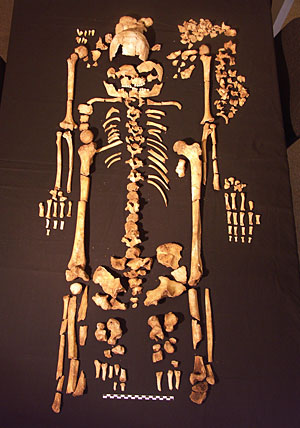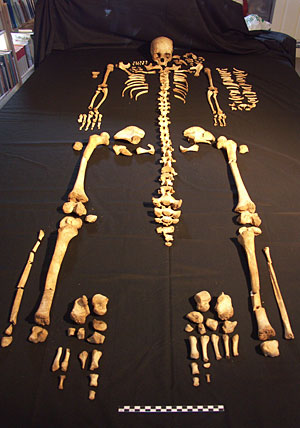The Iron Age
The scarp edge enclosure, or hillfort, at Fin Cop is one of the
larger in the Peak District, enclosing four hectares. The monument
has a single rampart, ditch and counterscarp bank, along which
at the northern end of the earthworks is a second outer bank and ditch.
Fin Cop, perched on a prominent hilltop, appears to be a true
‘hillfort’, which encloses a substantial area and
has a clearly defensive circuit. Excavations have shown that the
main rampart was built of, and faced with, stone. It likely stood
to a height of 3m or more, evidenced by the amount of wall tumble
found in the ditch. The rock-cut ditch in-front of the wall was
over 2m deep and 5m wide, and was constructed with a vertical
inner face. Beyond the rock cut ditch towards the north end of
the east-facing circuit, a secondary bank and ditch are defined
as surface features. All these features characterise a defensive
circuit which is consistent with the defence of a hillfort.
The excavation of the ditch revealed unfinished sections, which implies that the defensive circuit was never entirely completed. The initial season of excavation in 2009 concentrated on an area which may have been the remains of a blocked-up entrance, where the ditch terminated at a short section of unexcavated causeway before resuming on the other side. However, after examination of the suspected blocking, this was shown to not be the case. Construction of the outer rampart and ditch appears to have begun just prior to the destruction of the hillfort, and so was rushed and never completed. The evidence suggests that both the wall and ditch were built in several sections, perhaps by different work teams. Through comprehensive radiocarbon dating it has been shown that the hillfort was constructed in the period 440-390 cal BC (68% probability).
The discovery, during the 2009 excavation, of a female skeleton (Skeleton 1) in the ditch
fill suggested that the end of the hillfort was violent. The female
was aged between 21 – 35 years, and
the bones displayed signs of unhealed bruising which most likely occurred when the body was thrown into the
ditch along with the rocks of the dismantled rampart. The female skeleton did not display any evidence of significant
degenerative disease, possibly suggesting she did not undertake
much physical labour, but did have a tooth cavity and periodontal
disease, possibly as the result of a sugary diet. Together this
could perhaps suggest that she was of a higher rank within society. The uneven angle of the skeleton in the ditch
suggests a casual disposal of the body, rather than a special
deposit made with care, and that it was immediately covered with
rocks from the destroyed rampart suggests a rapid disposal. During analysis of the human remains after the first year's excavations, it became evident that the woman had either been heavily pregnant, or had been thrown into the ditch with a baby, as fragmentary pieces of a very young child's skeleton were also found.
During the second year's excavations, the remains of a further eight bodies were found, having been thrown into the ditch as the wall was pushed in. These included another two women, a male teenager, a young child, and four babies. This destruction of the rampart, and the hillfort's violent
and bloody end, suggests that it was levelled
to prevent it being used; this stands in opposition to the pacification
of hillforts in academic literature that has occurred over the
past decade or so. The destruction of the hillfort occured shortly after the radiocarbon date of 440-390 cal BC, and certainly within less than two hundred years.

Skeleton 3, a female, aged early 20's |

Skeleton 8, a teenage male |
It is currently unknown whether the hillfort was occupied on
a permanent or seasonal basis, and further investigation is required
to test this. Concentrations of ceramic materials discovered within
the hillfort indicate that there was domestic occupation in the Late Bronze Age, prior to the construction of the ramparts, and evidence
for structures may yet survive. That the inhabitants of the hillfort ate major domestic animals, such as cattle, pig, and sheep/goat, is indicated by small fragments of animal bone recovered from the primary ditch silt. Whether these remains represent slaughter and butchery waste is open to interpretation, due to the small size of the assemblage and general state of preservation.
|